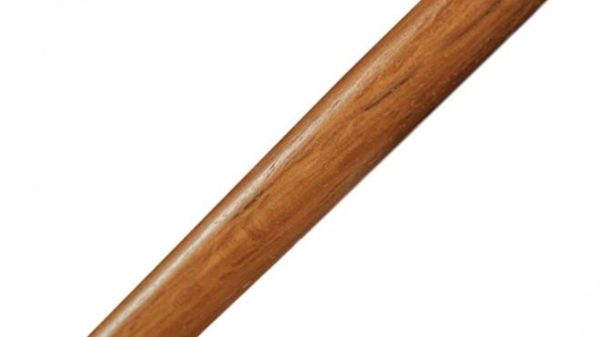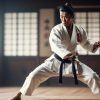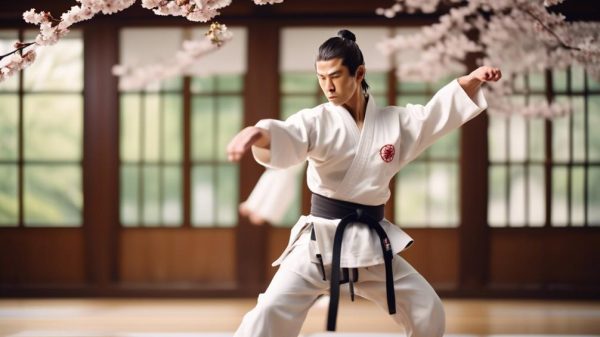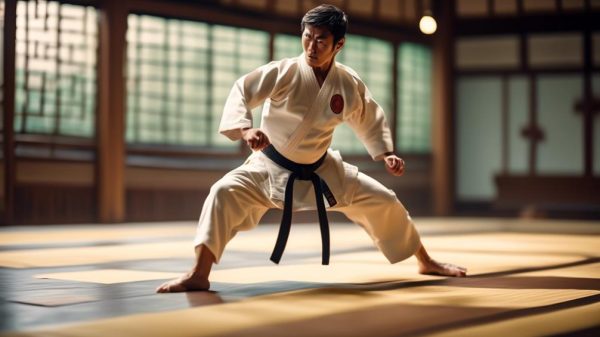Named in tribute to a Chinese sailor who endured a harsh shipwreck yet persevered by fighting off starvation and pirates, the kata Chinto develops similar rugged determination against extreme adversity.
Just 36 total steps performed linearly, simplicity allows channeling energy inwards for resilience.
Chinto applies signature double knife hand blocks with anchored triangles stances, developing all plane awareness.
Techniques center on destructive sequences: eye gouges and strikes flow into crushing joint locks tying limbs. Advancing steps stay planted in tension.
Ferocious two finger spears and vertical fist punches penetrate deeply into anatomy’s fragile pillars.
This Chinto breakdown diagrams sections of the sequence with descriptive steps, photos and videos.
Scrutinize your stance integrity, hip/shoulder coordination, finishing extension and kiai points against the reference materials.
Temper body, mind and spirit against life’s storms through this form!
Origin of Chinto Kata
The fascinating history of Chinto Kata traces back to its roots in the martial arts tradition of Okinawa, where it played a pivotal role in Shito-Ryu karate.
Reflecting the indomitable spirit and strategic acumen of ancient warriors, this form, meaning ‘fighting to the east,’ represents more than just a series of movements; it encapsulates the very essence of combat philosophy, demanding unwavering dedication to unravel its intricacies.
Crafted by Master Chojun Miyagi, Shito-Ryu Kata Chinto stands as a testament to the fusion of swift, impactful strikes and the graceful harmony of open-hand techniques and kicks.
Its robust stances, rapid maneuvers, and seamless transitions mirror both physical prowess and mental resilience.
To truly grasp the origins of Chinto Kata, one must immerse oneself in its rhythm, allowing each motion to be powered by breath and sharpened by focus.
Mastery extends beyond the confines of the dojo; it requires forging a connection with the kata’s heritage, delving into its history, and internalizing its strategies.
Key Movements Explained
Understanding the core movements of Shito-Ryu Kata Chinto is essential to mastering this kata’s unique blend of agility and strength.
The key movements in Chinto emphasize the fundamental principles of Shito-Ryu, including swift and precise strikes, open-hand techniques, and dynamic kicks.
Each technique requires focused attention, with proper breathing serving as the foundation for generating power and enhancing concentration.
The kata’s robust stances form the basis for stability and power execution. Practitioners learn to perform rapid movements and seamless transitions with unwavering control.
This goes beyond rote memorization of sequences; it’s about embodying the spirit of Chinto, synchronizing breath with each strike, and making the body an extension of one’s will.
Dedication to regular practice is crucial for refining physical fitness, cardiovascular endurance, and muscular strength.
To progress toward mastery, seek guidance from a qualified Shito-Ryu karate instructor or become part of a dojo where the nuances of Chinto can be honed.
It’s important to engage wholeheartedly with every motion, as each movement embodies the legacy of Shito-Ryu Kata Chinto.
Stance Transitions and Footwork
Chinto’s fundamental movements lay the groundwork for exploring the significance of fluid and stable footwork in this kata.
In the realm of karate katas, transitioning between stances and footwork involves more than just moving from one point to another; it encompasses executing each technique with a strong sense of purpose.
Your footwork forms the foundation on which the effectiveness of the kata is established.
While practicing Chinto, focus on the smoothness with which you shift between stances.
This goes beyond correct stepping; it involves the subtle shift of your weight and the precise positioning of your feet to maintain balance.
Envision your feet as brushes creating a masterpiece on the dojo floor—each movement deliberate, contributing to the overall portrayal of power and grace.
As you practice your stance transitions, you’re not only training your legs; you’re refining your ability to anchor each punch, block, and kick with the full force of your body.
Pay attention to how your footwork synchronizes with your hand techniques—this synchronization transforms good karate katas into outstanding ones.
Mastery calls for you to strive for that seamless dance of limbs, where each step is as intentional as the strike it precedes.
Breathing Patterns and Rhythm
Syncing your breath with each precise movement in Chinto evokes a powerful sense of harmony; it embodies the art of uniting breath and motion.
As you practice, your kata’s rhythm becomes akin to a pulsing heartbeat, guiding your inhalations and exhalations with the grace of a seasoned warrior.
Mastering these breathing cues brings about a transformation, enhancing your agility and focus with each controlled breath.
Harmonizing Breath With Movement
Learning to synchronize your breath with movement is crucial in mastering Shito-Ryu Kata Chinto. Each inhalation and exhalation should align with the precise actions, infusing your martial prowess with the necessary energy.
Deep diaphragmatic breathing fuels your focus and sustains the flow of your Hayashi-Ha Shito-Ryu Kata, enhancing your overall performance.
Here’s a breakdown of how to harmonize breath with movement during the kata:
- Preparation Phase: Inhale deeply to center your energy and ready your stance.
- Execution Phase: Exhale with precision as you strike and block with intent.
- Regulation Phase: Maintain rhythmic breathing to match the kata’s pace and uphold concentration.
Harmonizing breath with movement goes beyond being a technique; it reflects your dedication to the art.
Each breath you take becomes a step toward mastering Shito-Ryu Karate katas, embodying the spirit and discipline that define your martial arts journey.
Rhythmic Kata Execution
Mastering the rhythmic execution of Shito-Ryu Kata Chinto involves more than just physical prowess. It’s a delicate balance of power and grace, where every movement is guided by the rhythm of your breath.
The synchronization of your breathing with precise strikes and blocks is at the core of proficiency in karate katas.
This synchronization turns your practice into a seamless flow of energy, akin to a dance of combat. It’s not just a display of technique; it’s a form of art that reflects the true spirit of Shito-Ryu.
As you perform the kata, remember that your breath serves as the metronome, dictating the cadence of your movements.
This meditative rhythm requires utmost mental concentration, transforming your execution into a captivating expression of the martial art.
Breathe life into your kata and let the rhythm empower you to embody the essence of Shito-Ryu.
Inhalation and Exhalation Cues
Understanding the delicate balance between inhalation and exhalation is fundamental to unleashing the full potential of your Shito-Ryu Kata Chinto performance.
As you refine your katas, keep in mind that each breath infuses your karate with purpose and strength.
Inhale deeply during preparation to gather your inner power, and exhale sharply when striking to release that power with precision.
Below is a breakdown that encapsulates the essence of breathing in Chinto kata:
| Phase | Inhalation | Exhalation |
|---|---|---|
| Preparation | Deep, focused | – |
| Execution | – | Forceful, controlled |
| Transition | Calm, steady | – |
| Impact | – | Explosive, deliberate |
| Reflection | Slow, reflective | – |
Embrace the calm with each inhale and exhale the storm with each exhale.
Mastering these cues is not just about technique—it’s about embodying the spirit of karate.
Application in Kumite
In Kumite, the application of Shito-Ryu Kata Chinto is evident as you seamlessly integrate its precise techniques into your sparring strategy.
Each stance and strike you have mastered becomes a fluid expression of combat, enabling you to anticipate your opponent’s movements and respond with the finesse of a seasoned fighter.
Embrace this dynamic training ground, where the essence of the kata sharpens your reflexes, and each controlled exchange refines your martial artistry to its highest potential.
Kumite Strategy Development
Developing a successful kumite strategy goes beyond physical strength; it requires a keen intellect to identify and exploit an opponent’s weaknesses with strategic precision.
Refining karate techniques, including kicks and strikes, is essential to establish dominance in the ring.
To enhance your kumite game, consider the following strategies:
- Study your opponent’s patterns to uncover vulnerabilities.
- Diversify your offensive and defensive repertoire for unpredictability.
- Engage in mental rehearsal to sharpen your reaction time.
- Master timing and distancing to assert control during the fight.
- Employ feints and deceptive techniques to create openings for strikes.
Embrace these tactics wholeheartedly and with a thoughtful mindset.
They form the foundation of a sophisticated approach to kumite, where mastery isn’t an endpoint but an ongoing journey.
Chinto Kata Techniques
Master the art of Chinto Kata’s dynamic strikes and sturdy stances to enhance your kumite performance.
Transform rehearsed movements into spontaneous combat artistry by immersing yourself in the Shito-Ryu Kata Chinto.
This isn’t just about learning a sequence of moves; it’s about embracing a symphony of techniques that amplify your martial skills.
Each punch, palm strike, and kick is executed with precision and purpose.
Your stances act as the bedrock, providing stability as you seamlessly transition between offense and defense.
Focus on intentional breathing to fuel your agility and concentration, allowing your body to act as an extension of your will.
The path to martial excellence lies in dedicated practice of these katas, refining your technique and paving the way to mastery.
Training Tips for Mastery
To excel in Shito-Ryu Kata Chinto, you must start by meticulously honing the basic movements and stances, ensuring each technique reflects precision and correct form.
Mastery isn’t simply about repetition; it’s about embodying the spirit of each move, fully engaging your body and mind in the pursuit of perfection.
Consider these training tips for mastery, as they’re integral to your journey in mastering Chinto:
- Focus on Fundamentals: Ensure your foundation is rock-solid before advancing to more complex maneuvers.
- Pace and Power: Integrate speed and strength gracefully, maintaining control and fluidity.
- Mental Sharpness: Cultivate deep mental focus to enhance your timing and rhythm, essential components of a flawless execution.
- Consistent Practice: Dedicate time regularly to practice; consistency is your ally in the quest for proficiency.
- Expert Guidance: Seek out experienced Shito-Ryu instructors, utilize instructional resources, and train in an environment conducive to learning.
Your passion for the katas will be evident in the quality of your practice.
As you internalize these training tips for mastery, remember that the pursuit of excellence in Shito-Ryu Kata Chinto is a marathon, not a sprint.
Stay committed, reflective, and passionate, and mastery will be within reach.









